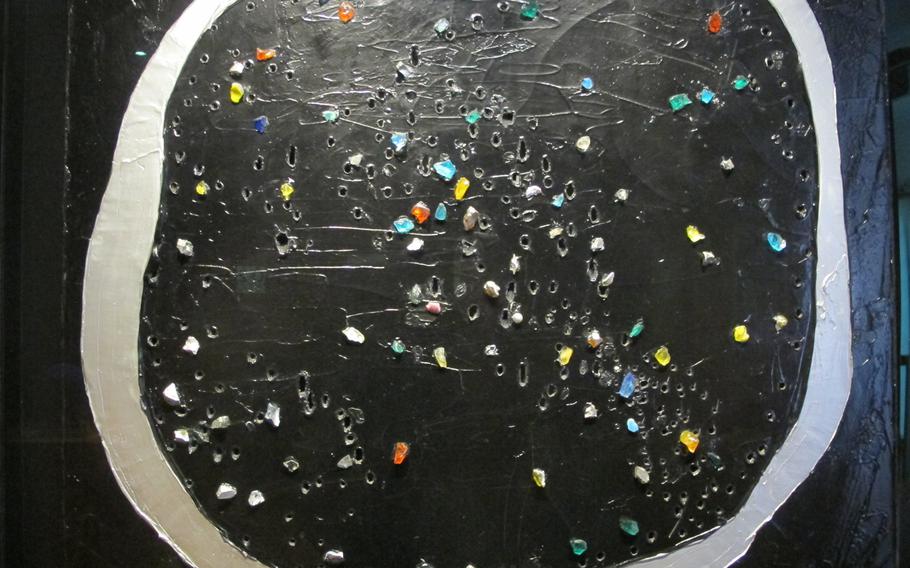
"Concetto spaziale: La Luna a Venezia," or "Spatial Concept: the Moon in Venice," was made by Lucio Fontana of acrylic and glass in1968. It is included in Gallerie d'Italia's exhibition in Vicenza, Italy, exploring the idea of the future from the 1960s to the present. (Nancy Montgomery/Stars and Stripes )
One of Vicenza’s art museums has reopened after months of coronavirus lockdown with a new exhibit that looks at the future as envisioned by the past, and asks: What now?
“FUTURE | Art and society from the sixties to tomorrow” opened this month and runs until February 7 at the Gallerie d’Italia, a baroque palace in the old town with a permanent collection of Renaissance art.
The exhibit starts with a timeline of events from the 1960s to 2020 that’s an education in itself. The Kennedy assassination is listed during the ’60s, as are Mary Quant’s invention of the miniskirt and Sean Connery’s appearance as James Bond. The 1970s includes the founding of Doctors Without Borders, the fall of Saigon, the death of Spanish dictator Francisco Franco and the founding of Microsoft. John Lennon’s murder, Ronald Reagan’s election to the presidency, Poland’s Solidarity movement and the first artificial heart transplant are listed for the ’80s.
The ’90s and the 2000s also get their due, and for the last year, 2020, there’s just one thing listed: “The spread of the Coronavirus causes hundreds of thousands of deaths around the world,” it says.
“Each time has its own idea of the future, and what we live today is much more uncertain than what happened 60 years ago,” according to the exhibit curation. “By an interesting and unpredictable coincidence, we found ourselves living in the turn of a century and a millennium. We looked forward to the first day of 2000 with great expectations and some fear. Twenty years later, what has really changed? And art, even in the light of what is happening on the planet today, is it still able to intercept the changes and tell them?”
About 100 works by international artists, including Andy Warhol, Roy Lichtenstein and Robert Rauschenberg, feature in the exhibit. And, boy, do they pop.
Moving through the exhibit rooms and the decades, contemporary works from spacey to mesmerizing to political to puzzling are on view, complemented by quotes on the wall from everybody from the Rolling Stones to Marshall McCluhan to the Brothers Grimm.
At least two of the works change form while you look: a luminous blue orb by Italian artist Grazia Varisco and a video of the face of Donald Trump morphing into Vladimir Putin, by American artist Nancy Burson.
Near the end of the exhibit, works concerned with the environment are featured. A collection of serigraphs made in 1971 by famous American artists, including Georgia O’Keefe, close it out. “Save Our Planet,” they say.
montgomery.nancy@stripes.com Twitter:@montgomerynance
DIRECTIONS: Address: Gallerie D’Italia, Vicenza, Italy
TIMES: 10 a.m. to 6 p.m. Tuesdays to Sundays; closed Mondays.
COSTS: 5 euros for adults, free for those under 18.
FOOD: Plenty of restaurants within a block or two around Vicenza’s main piazza. A cafe is a few feet away.
INFORMATION: Phone: (+39) 800-578875; email: info@palazzomontanari.com